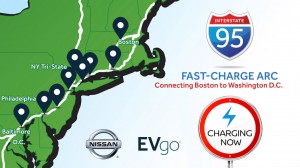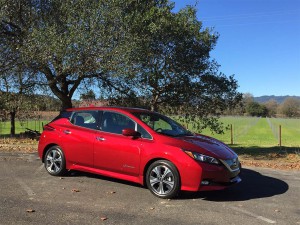
Nissan and EVgo just completed a 500-mile corridor of nine fast charging stations on I-95 between Boston and Washington D.C.
Nissan and EVgo have completed the installation of a series of nine electric vehicle fast charging stations along 500 miles of the I-95 corridor in the Northeastern corner of the United States.
The completion of the Northeast fast charging corridor provides a comprehensive charging infrastructure, offers owners of electric vehicle peace of mind and convenience when travelling the heavily-traveled corridor, stretching from Boston to Washington D.C.
Fear of “running out of electrons” is often cited as one of the primary reasons consumers shy away from purchasing or leasing battery-electric vehicles even though the range of EVs is gradually improving. Price is also a major factor inhibiting the growth of electric vehicle sales, according to analysts but the need for charging capacity remains a major factor in limiting sales of EVs.
However, manufacturers are under pressure to find ways to sell more EVs and contributing to construction of a broad charging network.
(Walmart set to add super fast chargers in 34 states. Click Here for the story.)

Nissan Leaf owners driving I-95 between Boston and Washington D.C. have nothing to fear when it comes to getting a charge.
“We’re excited to continue pioneering the development of electric vehicle infrastructure with the opening of our second charging `corridor’ project in the U.S.,” said Brian Maragno, director, EV sales and marketing, Nissan North America Inc.
“This charging route along one of the most heavily populated areas of the country further demonstrates our commitment to the mass implementation and future development of easily accessible EV technology and will foster EV travel up and down the Northeastern coast of the United States,” he said.
Each fast charging station along I-95 can charge up to four or more EVs simultaneously at a power output of 50kW. The stations have also been designed and constructed to adapt to future advances in EV technology, including pre-wiring for higher charging outputs to allow easy upgrading to 150kW fast chargers, officials from the two companies said.
Owners of Nissan Leaf can charge their vehicles up to 80% in only 30 to 40 minutes when using one of the DC outlets.
(Click Here for more about the challenges mass EV charging presents.)
“EVgo and Nissan’s I-95 Fast Charging ARC is designed to make fast charging easy and convenient for EV drivers from Boston to Washington D.C.,” said Cathy Zoi, the CEO of EVgo.
“Because we own our fast charging stations, EVgo drivers can rely on us to offer exceptional service from coast to coast. We applaud Nissan’s historic leadership in infrastructure investment in partnership with EVgo, affording drivers the opportunity to rely on the I-95 Fast Charging ARC today.”
As part of the initiative, all charging stations feature both CHAdeMO and Combined Charging System fast charging outlets providing access to all EVs available today with fast charging capability.
As part of Nissan’s “No Charge to Charge” program, owners of Nissan Leaf models can charge their vehicle for up to 30 minutes charging at no cost at any participating fast-charge station. Leaf owners are eligible for this program for two years following their time of vehicle purchase.
(BCG study forecasts 50% of vehicles sold in 2030 will be “electrified.” For the story, Click Here.)
The I-95 Fast Charging ARC is the newest addition to EVgo’s charging network that includes more than 1,000 fast charging stations spanning 34 states.


Nissan is an idiotic company – they are practically the only company using the CHAdeMO charging protocol, which is doomed, doomed, doomed. As we speak the worldwide standard protocol, CCS,is being installed around the world for the 250 electric cars that will appear on the roads and use CCS during the next several years.
“… doomed, doomed, doomed.” Sounds faintly like something Elon would say.
“Owners … can charge their vehicles … in only 30 to 40 minutes…” Hopefully all of these charging stations are located near restaurants or other places of respite. Otherwise, 30 to 40 minutes will seem much longer. Or course, if you develop a regimen of always topping up the charge whenever/wherever you stop, the issue of charging may become one not of time, but of practice. (Assuming some ICE vehicle isn’t parked in the charging space.) Maybe vehicle mounted solar cells will eventually help in alleviating this.
Allen, as I have reported several times, all indications suggest that the average EV owner currently does, and likely will continue to, charge primarily at home or office. Overnight charging, in particular, makes sense for a number of reasons, including the fact that the grid is generally underutilized. That would allow a large share of today’s IC-powered vehicles to go electric with minimal impact in terms of the need for new generating capacity. And folks would almost always find themselves starting the day with the equivalent of a full tank. There is a need for public charging stations — even as the average EV range pushes to 200 and above, however. People forget to charge, travel away from home or simply experience that occasional situation where they need to “top off.” And there will be commercial vehicles, whether Tesla’s semis or electric Mercedes Sprinters running routes for UPS, that will need to recharge on the go.
But most of the folks in the charging industry acknowledge they won’t need to make a 1-1 replacement for the existing refueling infrastructure.
That said, the super-high-speed systems that are just rolling out will be incredible energy consumers. A 375 kW charger would draw about as much energy as an entire suburban block. Now imagine a 10-charger station ala what we see on freeway interchanges. They will require full substations to power them up.
Paul E.
“Overnight charging…makes sense…(because)…the grid is generally underutilized.” So now my question is, once 30 to 50% of the households have 1 to 3 EVs which are all being charged, will the grid still be underutilized? “A 375 kW charger would draw about as much energy as an entire suburban block.” Among the households charging their cars/trucks/SUVs/CUVs at night, how many will be using 375kW chargers? I am sure all of this will be worked out in time. Just wondering how far along the thought process has gone to account for the practices that are likely to occur. And (just wondering), will the household charging rates include applicable road taxes?
Allen, you won’t see 375 kW chargers at home. If you did, (and the cost would be massive and illogical for a homeowner), you’d likely see it run for 5-10 min and would link to the grid to choose when to charge, stabilizing demand. More likely, people will continue to run relatively low-wattage 220V home chargers and the grid demand would be absorbable for the foreseeable future. 2050, if EVs were to be the norm, perhaps that would strain the grid.
Intriguing question, meanwhile, about pricing. Right now, utilities are willing to give overnight current on the cheap because they otherwise get nothing for it. That could change as demand grows…
AND the new issue becomes one of taxation. We could see things shift in several ways: $ per kW on a charger…or a per/mile fee, the latter seeming the most likely.
Paul E.
“…375 kW chargers at home. …(… the cost would be massive…”. Of course you do realize what that really means: the 1% will install them just because they can for bragging rights. But you are right: with only 1% of the 1% using their hyper chargers 1% of the time, the effect on the grid should be negligible.